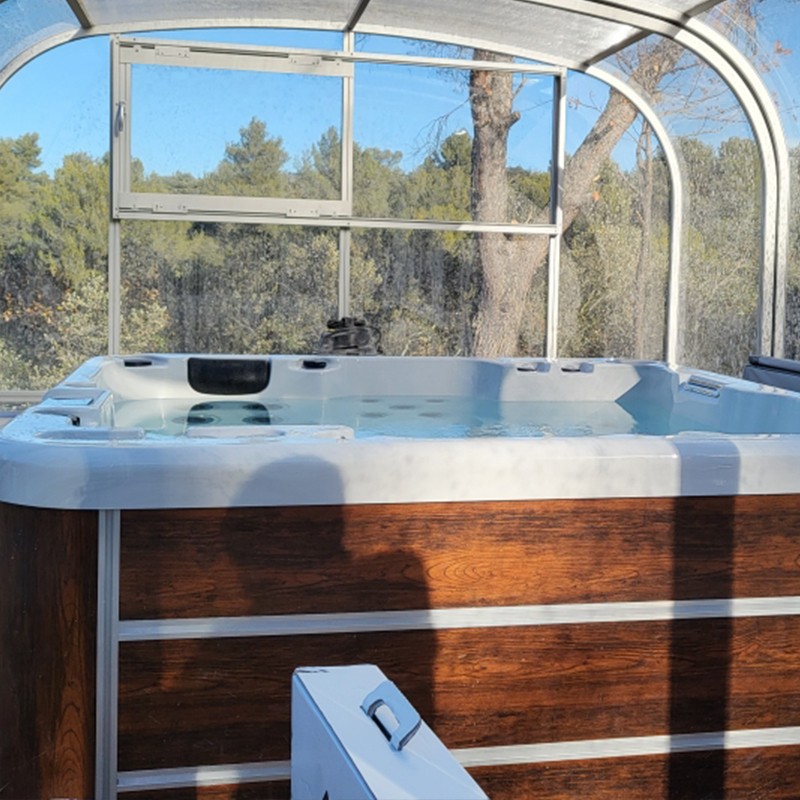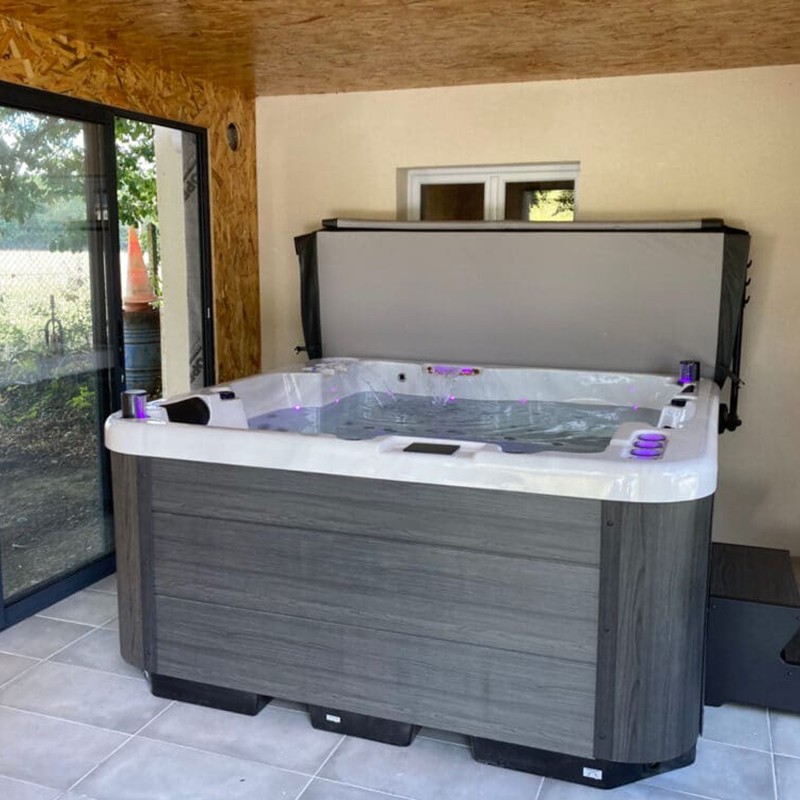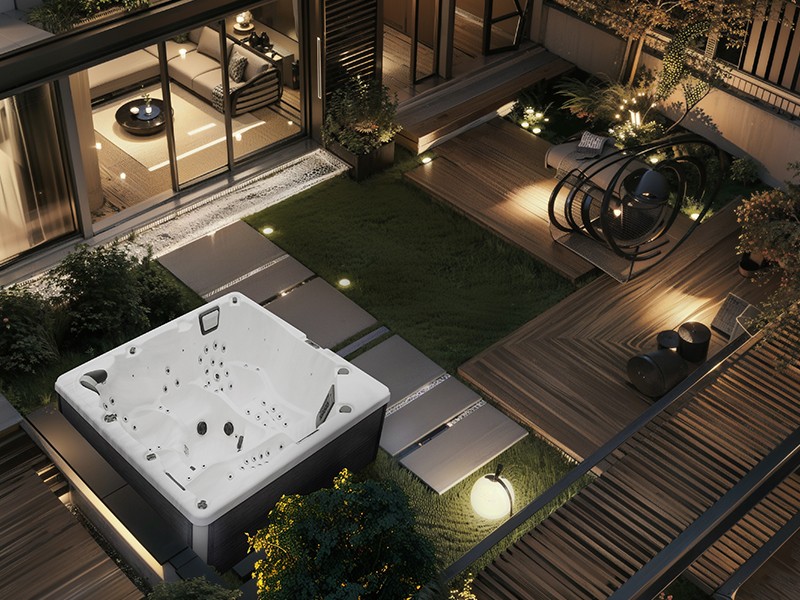
Are freestanding hot tubs fixed to the floor?
2024-11-08 15:30As a luxury device in home decoration, freestanding hot tubs have become increasingly popular among consumers in recent years. Its elegant design, versatile usage and flexible placement make it one of the first choices for many people when decorating their bathrooms. When discussing freestanding bathtubs, many people will ask a key question: Does a freestanding hot bathtub need to be fixed to the floor? This question involves multiple aspects such as installation method, structural safety, and user experience, so it is worth in-depth discussion.
This article will answer this question in detail to help consumers understand the need for fixing freestanding bathtubs, explain the technical details involved in installation, and discuss closely related aspects such as floor load-bearing, structural safety, drainage and pipe layout.
What are the characteristics of a freestanding hot tub?
Before discussing whether it needs to be fixed, first understand the design features of a freestanding hot tub and the difference from a traditional bathtub. Freestanding bathtubs are not attached to the wall or embedded support structure, but are exposed on all four sides and can be freely placed anywhere in the bathroom. This type of bathtub has a beautiful shape, with both simple modern design and traditional retro style. Common materials include cast iron, acrylic, ceramic, resin, etc. Due to its freestanding design, it has no physical connection to walls or other building structures, but relies on its own weight to stand firmly on the ground.
This free-standing design provides flexibility for the installation of the tub, suitable for bathrooms of various sizes and styles. However, such a free-standing structure also raises questions about fixing and stability.
Do free-standing tubs need to be fixed?
Strictly speaking, most free-standing hot tubs do not need to be fixed directly to the floor when installed. This is because the design and materials of free-standing tubs are usually stable enough, especially when filled with water, and the weight is greatly increased, so it is not easy to slide or tilt.
Weight and stability
The weight of a free-standing tub is an important factor in its stability. Typical free-standing tubs weigh between 150 pounds and 500 pounds (about 68 kg to 227 kg), depending on the material and size. When the tub is filled with water, the weight increases further. For example, a standard-sized free-standing tub can weigh more than 1,000 pounds (about 454 kg) when filled with water. Such a heavy structure is usually not easy to move, so additional fixings are not required.
Cast iron bathtubs are heavier and more stable due to their high density. Modern acrylic bathtubs are lighter, but they are usually designed with a wider base, which can remain stable even after filling with water, so no additional fixings are required.
Foot design
Most freestanding bathtubs have specially designed feet or bases at the bottom. These feet not only provide support for the bathtub, but also help maintain the stability of the bathtub. Some bathtubs have anti-skid feet to prevent the bathtub from sliding on smooth floors. Vintage-style freestanding bathtubs usually have four delicate claw-shaped feet, while modern-design bathtubs may have a larger flat bottom structure, which can evenly distribute weight and enhance the stability of the bathtub.
One of the important functions of these foot designs is to keep the bathtub level and stable without fixing it, especially on smooth floors such as tiles. Therefore, in most cases, the weight of the feet and the bathtub itself is sufficient to ensure the stability of the bathtub, and no additional ground fixings are required.
Choice of floor material
Although freestanding bathtubs do not need to be fixed to the floor in most cases, the material and treatment of the floor will also affect the stability of the bathtub. If the bathroom floor is too smooth, such as when using highly polished tiles, there is a risk that the bathtub may slip slightly during use. In this case, it is recommended to add anti-skid mats or other support devices between the bathtub feet and the ground to ensure its stability. In addition, if the ground is slightly uneven, you can also use adjustable bathtub feet to ensure that the bathtub remains level.
Special cases of fixing requirements
Although freestanding hot bathtubs do not need to be fixed in most cases, in some special cases, such as uneven ground or light bathtub structure design, some fixing measures may be required. To ensure safety, you can choose to connect the bathtub base to the floor with ground bolts or other fixings during installation, especially when the ground is sloped or the bathtub is placed in a high-traffic area.

Consider the bearing capacity of the ground
When installing a freestanding bathtub, in addition to considering the fixing of the bathtub itself, the bearing capacity of the ground is also a very important factor. Freestanding bathtubs will exert great pressure on the floor when filling and using, so you should ensure that the ground can withstand this weight before installation.
Floor structure
In high-rise residential buildings or multi-story buildings, the bearing capacity of the ground is limited. If the weight of the bathtub is too large and the ground is not able to bear the weight, the floor may deform, crack or even collapse. Therefore, it is recommended to find a professional to evaluate the load-bearing capacity of the floor before installing a large free-standing bathtub to ensure safe use. Generally, the load-bearing capacity of residential floors is about 40 to 50 pounds per square foot (about 195 to 244 kilograms per square meter). For oversized bathtubs, additional floor reinforcement measures may be required.
Floor materials
The floor materials of the bathroom have a great impact on the stability and load-bearing capacity of the free-standing bathtub. Common floor materials include tiles, stones, wooden floors, etc. When choosing a location to install the bathtub, the strength and anti-slip properties of the floor materials should be considered. If the floor material is fragile or easy to slide, additional treatment may be required, such as laying anti-slip mats or reinforcing the floor structure.

The impact of drainage and pipe layout on bathtub installation
Although the free-standing hot tub does not need to be fixed directly to the floor, the layout of drainage and pipes is crucial during the installation process. When considering the drainage system, you should ensure that the bathtub can be effectively connected to the drain to avoid leakage or poor drainage during use.
Drainage design
Most freestanding bathtubs are designed with a bottom drain hole, usually located in the center or tail of the bathtub. During installation, the drainage pipe needs to be properly connected to the drainage system under the floor. If the bathroom drain outlet is not in the right position, it may need to be rearranged, which usually involves floor modification and pipe adjustment.
Flexibility of pipe layout
Since the design of the freestanding bathtub is not attached to the wall, the layout of the water inlet and outlet pipes is relatively flexible. This means that when choosing the installation location, it can be flexibly adjusted according to personal needs and bathroom layout. However, the distance between the bathtub and the water pipe should not be too far to avoid affecting the smooth flow of water. Therefore, it is recommended to carefully plan the pipe layout before installation to ensure smooth water flow and no risk of leakage.
Other considerations when installing a freestanding bathtub
In addition to fixity, load-bearing capacity and pipe layout, the following points should be noted when installing a freestanding hot bathtub:
Positioning of the bathtub
One of the advantages of a freestanding bathtub is that it can be placed freely, either in the center of the bathroom or near windows, walls and other areas. Therefore, when installing, you need to consider whether the placement of the bathtub is coordinated with the overall space design, and ensure that it will not affect the normal use of other bathroom facilities after installation.
Convenience of getting in and out of the bathtub
Since freestanding bathtubs are usually deeper than built-in bathtubs, getting in and out of the bathtub may cause certain difficulties for some people (such as the elderly or people with limited mobility). Therefore, when installing, you should consider the height of the bathtub, and if necessary, you can install handrails or anti-slip mats to ensure safe use.
Cleaning and maintenance space around the bathtub
Freestanding bathtubs are exposed on all four sides, so when installing, you should leave enough cleaning and maintenance space to facilitate daily cleaning and maintenance. In addition, the footrest at the bottom of the bathtub may accumulate dust and dirt, so it should also be cleaned regularly.


